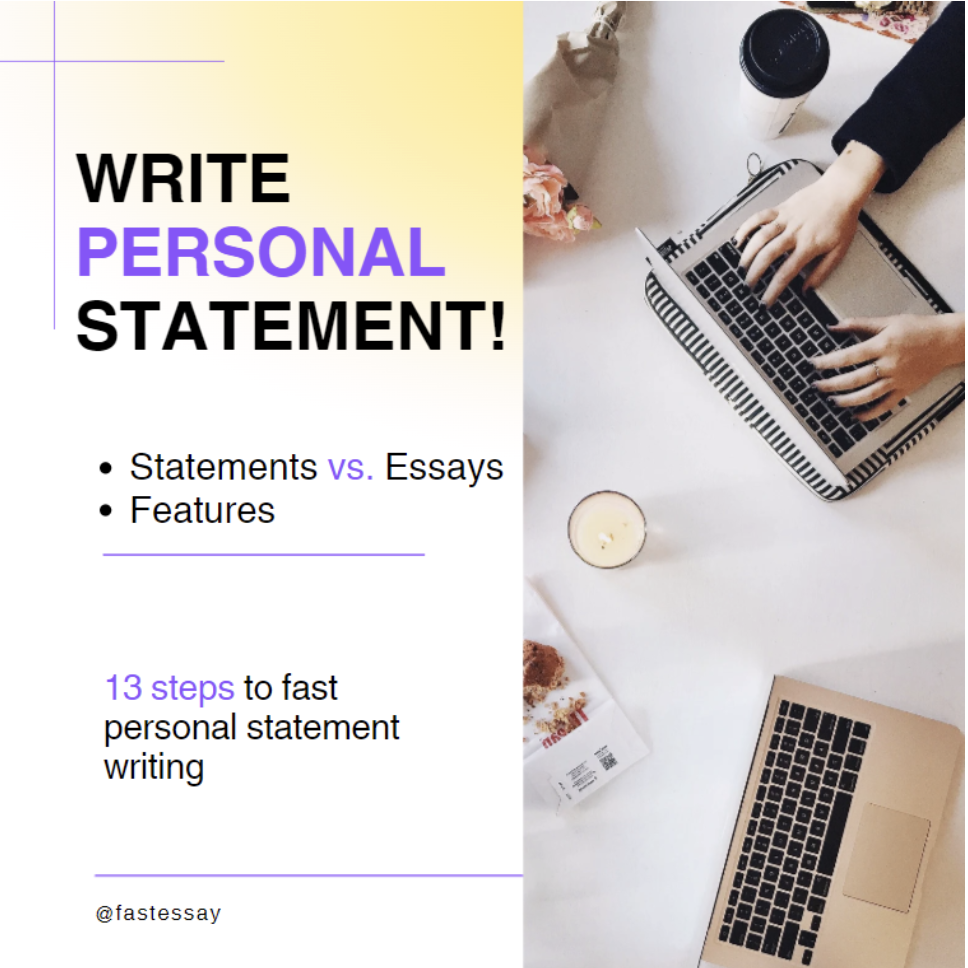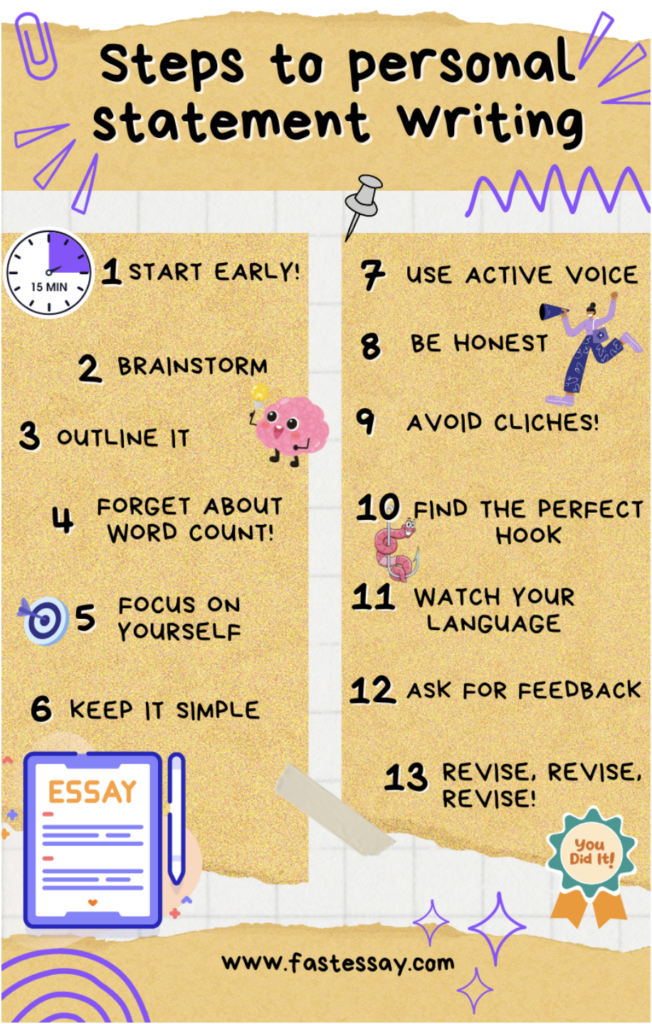In this blog post, you’ll discover the secrets of personal statement writing.
This short essay is an integral part of the university admission process. Whatever college you choose to enter, they’ll ask you to craft a personal statement that will allow them to know you better and see if you’re worthy of joining their community.
Let’s see what makes an excellent personal statement and how to write it to impress the admission committee.

What Is a Personal Statement?
First, the basics:
📝 A personal statement is an essay you write for the admission committee to get into college. It’s not dry info about your academic achievements but a compelling narrative revealing insights into your personality.
❓ Why do they want you to write a personal statement?
Admission officers want to see the personality behind all the grades, scores, and recommendation letters you submit with your application. They want to understand who you are, what motivates you, and how you would contribute to their campus community.
Your statement gives them additional insight into your interests and values. They’ll see your expectations regarding college and your ability to communicate and follow directions. While an excellent personal statement doesn’t guarantee admission, it still impacts a student’s application and chances of getting in. (Especially when a committee is choosing between several applicants with identical test scores and grades.)
Personal Statements vs. Classic College Essays
A personal statement is like a standard essay you write in school, right?
Not quite.
Personal statements share your qualities, skills, and values. They are more like stories, not the classic five-paragraph essays with a thesis-body-thesis restatement structure you used to write. Think of your statement as the “heart” of your entire college application:
It communicates the essence of who you are, both academically and personally.
Let’s compare the two, just to be clear:
| Essays | Personal Statements | |
| Purpose | Make an argument and support it with evidence | Demonstrate the qualities, interests, and values you’re bringing with you to college |
| Thesis | Explicit; in the first paragraph | Implied or not stated; if present, it’s often at the end |
| Tone | Formal, analytical | Casual, personal |
| Emotions | ❌ | ✅ |
| “I,” “me” statements | ❌ | ✅ |
| Result | The reader understands your thoughts | The reader understands your thoughts, feelings, ways of living, and motivations |
Three Features of a Good Personal Statement
- Your core values
- Your reflections and growth
- Your writing craft
The admission officer should get a sense of what excites, fulfills, and motivates you. When writing, communicate at least 4 to 5 different values throughout your statement. (These can be perseverance, humor, resourcefulness, community, diversity, you name it.)
Don’t be afraid to sound vulnerable in your paper. The personal statement is a great place to open up about something that bothers, scares, or challenges you. But:
Ensure that you also include 2-3 “so what” moments, the insights you’ve drawn from those experiences or reflections that speak to your sense of purpose. Help the reader take that journey of growth with you.
For that, build your statement as a narrative. Storytelling is a powerful instrument for engaging the audience, eliciting emotions, and immersing them in your story. It’s also an opportunity to demonstrate your writing craft to the committee:
While the content of your paper is essential, its structure, logical coherence, and readability also matter. Don’t make your statement sound too obvious or boring for the reader.
❓ How long is a personal statement?
Always check the guidelines to see if they provide specific instructions regarding the length. Unless otherwise noted, write between 500 and 1,000 words in your statement. (It’s somewhere between 2-3 pages.)
Stick to standard formatting:
- 4-7 paragraphs
- Double-spaced
- 1-inch margins
- Times New Roman, 12pt.
How to Write a Good Personal Statement Quickly
And now, to practice:
Below are your actionable steps for personal statement writing. Follow them — and you’ll craft a compelling and professional-looking paper quickly like our personal statement writing service can do for you.

1. Start Early
Personal statements are shorter and less research-based than the other papers you used to write in school. And that’s where you might hit a snag:
You risk the quality if you think you’ll write your story quickly.
Personal statements take longer than you expect. You’ll need to brainstorm and figure out what you’ll write about, and how to structure it into a compelling story that will impress the admission committee, then revise it several times to ensure that you’ve done your best.
👉 Here’s a tip: Start working on your statement 1-2 months before your deadline.
2. Take Time to Brainstorm Topics
What topic will you choose for a personal statement? It’s a crucial detail because your topic determines your approach to structuring your story.
Do you plan to write about challenges you’ve faced, what you did about them, and what you learned? A narrative, i.e., a classic story structure, will work here. Do you plan to share a series of your experiences and insights on a particular theme? Consider a montage structure.
In plain English, a narrative structure connects story events chronologically, while a montage structure does it thematically.
Take your time and think of a meaningful and original topic for your statement: people and events that have shaped you, life experiences that are unique to you, and how they’ve all impacted you.
3. Outline It
Seriously? Outlining a personal statement?
Yes.
It saves time on a draft and makes your writing better.
If you’re writing a narrative, specify the challenge you’ll describe and build bullet points for its effects, what you did about it, and the lessons you learned. For a montage, specify the experiences you’ll share and outline 4-5 ways they connect to different values, life lessons, and insights you’ve got.
4. Don’t Count Words While Writing
Turn off the word or character counter while drafting!
First, it will distract you: You’ll always look at it to see whether you‘ve reached or exceeded the word limit. Second, it won’t let your thoughts flow and tell everything you want to say in your paper.
❗ Just write. You’ll have an opportunity to revise it later. Deleting extra words is far easier than inserting more ideas while keeping the draft well-structured and within the required length.
5. Focus on Yourself
Be different from James Joyce, who crafted super-complex sentences with lengthy descriptions and explanations in his Ulysses. Avoid getting into long rants about the places you visited, the courses you took, or the organizations you volunteered for.
The committee is more interested in how those places and courses have influenced your motivation, perspective, and/or development. Since it’s a personal statement, YOU are its main focus.
6. Keep It Simple
Your writing skills also matter. You have a limited word count to share your story, so take your time to make it concise, clear, and compelling.
Structure sentences and paragraphs for better rhythm and readability. Mix up their lengths, but avoid filler and redundant words that don’t add any value to the message you’re communicating.
❗ Keep the text simple:
- Use the words you know, and don’t stuff your statement with lengthy or sophisticated lexical items to sound smart.
- Say no to confusing language that muddles your story.
7. Use Active Voice
You’re a protagonist sharing your journey with the audience. Using the active voice (with “I” in the subject position) makes your story more compelling, adds action, and allows the reader to relate to your storyline.
The more active verbs, sensory words, and descriptive adjectives there are in your text, the better.
8. Be Honest
Don’t embellish your knowledge and skills, and don’t take credit for work or accomplishments you don’t have. Why create a false image and seem better than you are?
First, the truth will come out anyway. Second, you do have experiences to share. (Yes, even if it doesn’t seem like that at first glance.)
❗ One more thing:
Never hide the elephant in the room. Make sure to mention the deficiencies (if there are any) that matter for your application rather than hoping the committee ignores them. They won’t.
9. Avoid Clichés
Remember:
The admission committee will read dozens of personal statements. Applicants will try hard to impress them, but let’s face it: Most essays are identical-looking and mediocre because of the ordinary topics or cliched phrases students use to represent their experiences.
Most write about inspiring, ground-breaking, and thought-provoking events. They describe how those events (or people) enthralled, ignited, or fuelled them. And that’s not evening mentioning their use of banal metaphors like “quenched my thirst for,” “burning desire,” or “sparked my interest.”
👉Make your statement stand out: Avoid such overused phrases in your text.
10. Find the Perfect Hook
What is a hook in an essay?
It’s the opening sentence that grabs the audience’s interest and motivates them to keep reading. What would be a nice hook to start your statement?
Think of something funny, unusual, or surprising. It can be a “wha-a-at?” fact or a provocative question. But don’t try to squeeze something witty out of nowhere: Make your hook relevant to your overall story.
11. Watch Your Language
Make friends with a thesaurus when writing your statement. Use synonyms to diversify your language and sound more professional.
“Presume” and “accomplish” sound more elegant than “think” and “do,” agree? Use the wealth of language to your advantage: Even if you’re an ESL student, translation and synonym programs on the web will help.
👉 The catch:
Don’t overplay it! Too many fancy words make your statement sound artificial and difficult to read.
12. Ask for Feedback
The more people you show your statement to before submitting it, the better. Ask parents, teachers, and friends to read it and provide feedback:
- What would they omit or revise?
- What grammatical or stylistic mistakes did they notice?
- What insights did you miss that they would mention?
Consider their comments to enhance the final version of your essay.
13. Revise, Revise, Revise!
Read your statement aloud to “hear” the flow. Awkward phrases, ambiguous statements, repetitions, typos, grammar mistakes, jarring transitions — remove them. Edit your draft with no mercy:
Polish the text the best you can. Proofread it several times to ensure that it’s concise, flows well, and responds to the prompt.
Long Story Short
With all these strategies on hand, personal statement writing won’t feel intimidating anymore. Now, you have everything you need to start writing and impress the admission committee with your essay.
Do you need examples to better understand the nature of personal statements? Feel free to ask us for a few samples!

